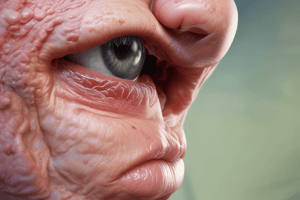Podcast
Questions and Answers
What is a characteristic feature of a maculopapular rash?
What is a characteristic feature of a maculopapular rash?
Which of the following conditions is most likely to present with a maculopapular rash?
Which of the following conditions is most likely to present with a maculopapular rash?
In what age group are maculopapular rashes most commonly observed?
In what age group are maculopapular rashes most commonly observed?
Which of the following best describes how a maculopapular rash might evolve over time?
Which of the following best describes how a maculopapular rash might evolve over time?
Signup and view all the answers
What is an appropriate management strategy for a maculopapular rash suspected to be viral in origin?
What is an appropriate management strategy for a maculopapular rash suspected to be viral in origin?
Signup and view all the answers
Study Notes
Definition and Characteristics
- A maculopapular rash is a skin eruption characterized by flat, discolored spots (macules) and raised, small bumps (papules) that appear together.
- The spots and bumps may vary in size, ranging from small to medium, and can be slightly or markedly elevated.
- Coloration can be varied, including red, pink, purple, or even brownish, and may blend into each other.
- The rash doesn't usually form blisters or pus-filled lesions.
- Distribution across the body can vary, from localized to widespread.
Possible Causes
- Infections: Viral (e.g., measles, rubella, fifth disease, Epstein-Barr virus), bacterial (e.g., some streptococcal infections), or parasitic.
- Medications: Many drugs can cause this type of rash as a side effect.
- Allergic reactions: Exposure to allergens (e.g., food, insect bites, environmental factors).
- Certain autoimmune diseases: Conditions like lupus erythematosus or dermatomyositis can manifest with maculopapular rashes.
- Drug reactions: A significant percentage of rashes are drug-induced; the exact mechanism can be complex and varies with the drug.
- Contact dermatitis: Exposure to irritants or allergens on the skin can cause a rash.
- Other conditions: Some less common conditions can also lead to this type of rash, including certain cancers or blood disorders.
- Systemic diseases: Examples include viral infections, diseases like scarlet fever, and certain auto-immune syndromes.
Evaluation
- History-gathering: Critical for diagnosis, including the onset, progression, possible triggers (e.g., medications, infections, exposure).
- Physical examination: Inspection of rash characteristics is vital – location, distribution, color, and size.
- Laboratory testing: Blood tests can help to identify specific infections, inflammatory markers, or other underlying conditions; this also depends on a number of factors including the clinical picture and patient history.
- Imaging tests: May be necessary to rule out certain conditions if indicated by the patient's history.
Differential Diagnoses
- Other skin rashes: Important to distinguish from other types of skin eruptions, such as urticaria (hives), erythema multiforme, or psoriasis.
- Systemic diseases: Certain systemic diseases can manifest with skin rashes, necessitating further evaluation to rule out these possibilities.
Treatment
- Treatment depends entirely on the cause, ranging from supportive care (e.g., topical emollients, anti-itch medications) to addressing the underlying illness or infection.
- If the rash is suspected to be a reaction to a medication, discontinuing the medication is often the initial step.
- Appropriate medications to treat the underlying cause are often directed toward a specific pathogen causing the rash or targeted to inflammatory markers and immune status as indicated.
- Topical corticosteroids are frequently used for specific skin conditions with inflammation.
- Antihistamines can provide relief from itching.
Complications
- Secondary infection: If the rash becomes broken or irritated, secondary bacterial infections may occur; important to prevent this.
- Systemic complications: Depending on the underlying cause, more serious systemic conditions may develop.
- Scarring: In certain cases, particularly with severe infections or injuries to the skin, scarring may occur within the area of the rash.
Prevention
- Avoiding known triggers (e.g., allergens, medications) can help to prevent the development of the rash.
- Maintaining good hygiene habits can also reduce the risk of infections, a common cause of maculopapular rashes.
- Prompt treatment of infections can help prevent the spread and complications of the infection that may manifest as a rash.
Studying That Suits You
Use AI to generate personalized quizzes and flashcards to suit your learning preferences.
Description
Explore the definition, characteristics, and possible causes of maculopapular rashes in this informative quiz. Understand the clinical presentation, including the variation in size and coloration, as well as the potential infectious, allergic, and autoimmune factors that may contribute to this rash. Test your knowledge on this important dermatological condition.




